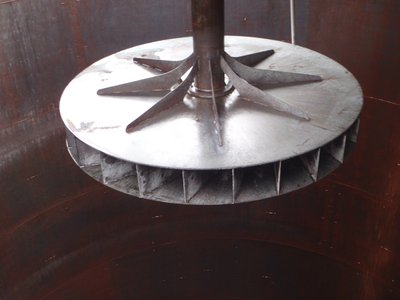Harnessing the power of a tornado in a tank
It does not always follow that the more complicated the technology and the more advanced the system, the better the outcome.
A smart mixing technology called swirl flow, developed by CSIRO and Queensland Alumina, greatly simplifies the mixing of solids in suspension in mineral processing. It works by creating a novel fluid flow pattern within large-scale tanks that mimics a tornado.
Suspension mixing is usually achieved using massive impellers attached to long shafts, at times 20 metres or more in length, resulting in the mixing equipment being heavy, unwieldy and costly. The mixing is not entirely efficient using this approach and the equipment can be costly to maintain.


Dr John Farrow, CSIRO’s commercial manager of swirl flow, says its unique mixing offers many advantages over traditional mixing systems.
“Swirl flow uses a radial agitator located just below the liquid’s surface to create a tornado-like flow pattern. The tornado effect extends all the way from the bottom of the tank, sometimes 30 metres or more, to lift any settling solids to the top of the tank. The fluid and solids then swirl downwards and repeat the process,” says Dr Farrow.
“The capital cost of swirl flow is around 50% less than traditional technologies, and likewise the maintenance costs are also much lower, in part due to the lower wear rates than the impellers used in traditional systems.
“Maintenance can also be done without entering the tank, creating a significant health and safety advantage.”
Swirl flow has been successfully used for more than 15 years by Queensland Alumina at its Gladstone refinery. Currently, 21 large tanks are operating with the technology, and the company has plans to convert more tanks to swirl flow.
Conversion to swirl flow is not only a major capital cost saving, but also provides long-term operating advantages such as a significant reduction in the tank scaling rate. This allows the tank to stay in operation for much longer periods, increasing production and reducing the costs.
“A particularly important feature of swirl flow is the ease at which remixing of the suspension can commence after a power failure, since the agitator is close to the liquid’s surface and away from the settled solids, unlike traditional systems in which the settled solids may cause the impeller to get stuck,” Dr Farrow explains.
Swirl flow can be applied throughout the minerals industry for a wide variety of mixing.
“We’re doing work for both the gold and zinc industries,” Dr Farrow says. “Gold production also has a crystallisation issue, and like the aluminium mixing, the process needs the best form of agitation to make sure particles are kept in suspension with no scale.
“For all applications the prime need is to ensure no solids settle to the bottom of the tank, but swirl flow can also address the need to avoid particle attrition (for example, when resins are used to absorb valuable metals), to provide effective oxygen transfer or to minimise scale formation.”
The Minerals Down Under Flagship of Australia’s national science agency, CSIRO, is one of the largest minerals research groups in the world and has a proven track record of working with industry to deliver innovative solutions. Through targeted research CSIRO addresses the industry’s challenges, driving sustainability, productivity and innovation for its collaborative partners and clients.
This story first appeared in resourceful: www.csiro.au/resourceful
Climate-friendly electricity from ammonia
Researchers the Fraunhofer Institute have developed a high-temperature fuel cell stack that can...
Digitalised, sustainable battery cell production
German researchers have developed a flexible winding system for battery cells that is embedded in...
Expired deadline threatens critical infrastructure as compliance lags
The deadline for achieving cybersecurity framework alignment for the SOCI Act expired on 17...












